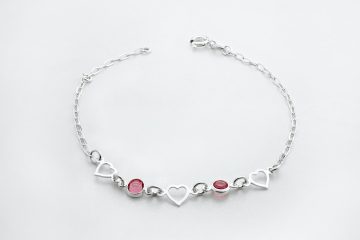In the world of jewelry making, bracelets hold a special place. They are versatile accessories that can add a touch of elegance and personality to any outfit. From delicate chains adorned with charms to intricately beaded designs, the art of bracelet making offers endless possibilities for creativity. But have you ever wondered how much time it takes to create a beautiful bracelet? In this article, we will delve into the intricate process of bracelet making, exploring the time required for crafting a truly remarkable piece.
The Journey Begins: Gathering Materials and Inspiration
Before embarking on the bracelet-making journey, one must gather all the necessary materials. The choice of materials depends on the type of bracelet one wishes to create. For instance, if you opt for a beaded bracelet, you will need beads in various shapes, sizes, and colors, along with a strong stringing material. Alternatively, if you prefer a metal bracelet, you will require metal links, clasps, and tools for manipulating the metal.
Once the materials are assembled, it’s time to find inspiration. Inspiration can be drawn from various sources such as nature, art, or even personal experiences. It is essential to have a clear vision of the desired design before starting the crafting process. This initial step of gathering materials and finding inspiration can take anywhere from a few hours to a few days, depending on the complexity of the design and availability of materials.
Designing the Bracelet: Sketching the Blueprint
Designing a bracelet involves translating the vision into a tangible blueprint. It’s like painting a picture on paper before bringing it to life. The first step is to sketch the design, mapping out the placement and arrangement of beads, charms, or other elements. This allows for a better understanding of how the bracelet will look once completed.
The sketching process can vary in time, depending on the intricacy of the design. Simple designs may only require a few minutes to sketch, while more complex ones may take several hours or even days. It is crucial to pay attention to every detail during this stage to ensure the final piece matches the envisioned design.
Choosing the Right Technique: Exploring Various Bracelet Making Methods
Bracelet making encompasses a myriad of techniques, each requiring different levels of skill and time commitment. Some popular techniques include stringing, bead weaving, wire wrapping, and macramé. The choice of technique depends on the desired design, materials, and personal preference.
Stringing is one of the simplest techniques, involving threading beads onto a string or wire. It is relatively quick and suitable for beginners. On the other hand, bead weaving involves intricate stitching techniques using a needle and thread. This technique can be time-consuming but allows for highly detailed and intricate designs.
Wire wrapping is a technique that involves manipulating wire to create various shapes and patterns. It requires precision and patience and can take a significant amount of time depending on the complexity of the design. Macramé is another technique that utilizes knots to create patterns and designs. It offers a unique and bohemian aesthetic but can be time-consuming due to the intricacy of the knots.
The Art of Assembly: Bringing the Design to Life
Once the design and technique are finalized, it’s time to bring the bracelet to life. This stage involves assembling all the components, following the blueprint and technique chosen. For stringing and wire wrapping techniques, it is a matter of threading or wrapping beads, charms, or other elements onto the string or wire. Bead weaving requires stitching beads together using a needle and thread, following the design pattern.
The assembly process can be time-consuming, especially for intricate designs or techniques that require meticulous attention to detail. It may take several hours or even days to complete, depending on the complexity of the design and the maker’s skill level. However, this stage is also where the maker’s creativity shines, as they bring their unique touch to the design.
Adding Finishing Touches: Clasps, Charms, and Personalization
The final touches of a bracelet are what truly make it stand out. These finishing touches include adding clasps to secure the bracelet, attaching charms for added flair, and personalizing the piece to reflect the wearer’s style. It is during this stage that the bracelet truly comes together, transforming from a collection of materials into a wearable work of art.
Choosing the right clasp is essential, as it ensures the bracelet stays securely on the wrist. There are various types of clasps available, such as lobster clasps, toggle clasps, and magnetic clasps. The choice depends on the design, functionality, and personal preference.
Adding charms can give the bracelet a personal touch or convey a specific meaning. Whether it’s a birthstone charm or a symbol that holds sentimental value, charms add an extra layer of significance to the piece. Additionally, personalization through engraving or attaching personalized pendants can make the bracelet truly one-of-a-kind.
The time required for adding finishing touches varies depending on the complexity of the design and the number of components to be attached. It can range from a few minutes to several hours, ensuring every detail is meticulously executed.
The Journey’s End: Celebrating the Completion of a Beautiful Bracelet
After hours or even days of meticulous work, the moment of completion arrives. The bracelet is now ready to be worn, admired, and cherished. The satisfaction of seeing a vision transformed into a tangible piece is unparalleled.
Crafting a beautiful bracelet is not just about the time invested, but also about the passion, creativity, and dedication poured into the process. Each bracelet tells a unique story and holds a special place in the heart of its maker and wearer.
As the bracelet adorns the wrist, it serves as a reminder of the artistry and craftsmanship that went into its creation. Whether it’s a gift for a loved one or a personal indulgence, a handcrafted bracelet is a treasure that transcends time.
FAQs:
1. Can I make a bracelet without any prior experience in jewelry making?
Absolutely! Bracelet making is a versatile art form that welcomes beginners. With the right materials, instructions, and patience, anyone can create a beautiful bracelet. Start with simpler designs and techniques, and gradually explore more complex ones as you gain confidence and experience.
2. How long does it take to become proficient in bracelet making?
Becoming proficient in bracelet making depends on various factors, such as the time dedicated to practice, the complexity of the techniques used, and individual learning abilities. With consistent practice and a willingness to learn, one can become proficient in bracelet making within a few months or even weeks.
3. Are there any specific tools required for bracelet making?
The tools required for bracelet making depend on the chosen technique. However, some essential tools include pliers, wire cutters, needles, and thread. It is advisable to invest in quality tools to ensure precision and ease during the crafting process.
4. Can I sell the bracelets I make?
Certainly! Many artisans turn their passion for bracelet making into a business by selling their creations. Online platforms, craft fairs, and local boutiques are popular avenues for showcasing and selling handmade bracelets. Researching the market, understanding trends, and developing one’s unique style can contribute to a successful bracelet-making business.
5. How can I care for my handmade bracelet?
To ensure the longevity of your handmade bracelet, it is essential to handle it with care. Avoid exposing it to harsh chemicals, excessive moisture, or extreme temperatures. When not in use, store it in a jewelry box or a soft pouch to prevent scratches or tangling. Regularly clean the bracelet using a jewelry cleaning cloth or a mild soap solution to maintain its shine and luster.




